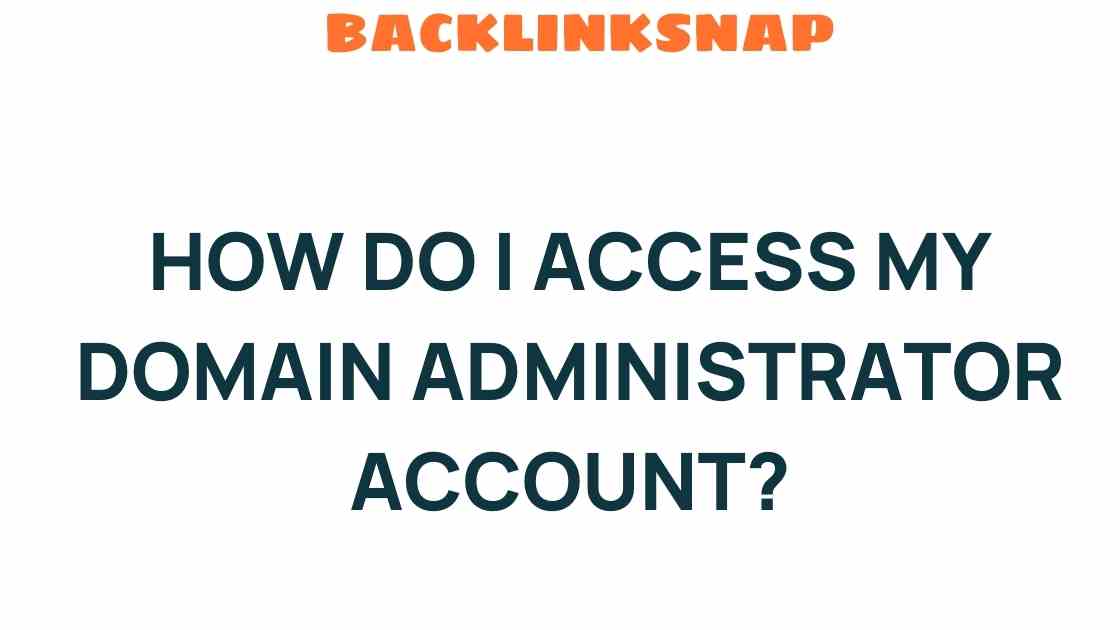Unlocking the Secrets: How Do I Access My Domain Administrator Account?
Accessing your domain administrator account is a critical aspect of managing IT security and user management within any organization. The domain administrator plays a pivotal role in overseeing network access, ensuring the integrity of admin credentials, and facilitating account recovery processes. In this article, we will delve into the methods, best practices, and insights for accessing your domain administrator account effectively and securely.
Understanding the Role of a Domain Administrator
A domain administrator is essentially the gatekeeper of your organization’s network. This individual holds the highest level of access within the domain, enabling them to manage user accounts, set security policies, and configure network settings. Given the significance of this role, it’s crucial to understand how to access your domain administrator account when needed.
Why Accessing Your Domain Administrator Account is Important
Access to the domain administrator account is essential for several reasons:
- User Management: Admins can create, modify, and delete user accounts, ensuring that only authorized personnel have access to sensitive information.
- Network Security: By managing security policies and permissions, domain administrators protect the organization from potential cyber threats.
- Account Recovery: In case of forgotten passwords or locked accounts, admins can reset credentials and restore access.
- IT Management: Effective management of resources and applications is made possible through the domain administrator account.
How to Access Your Domain Administrator Account
Accessing your domain administrator account can vary based on the operating system and the network setup. Here are some common methods:
1. Using the Windows Active Directory
If you are operating within a Windows environment, the primary way to access your domain administrator account is through Active Directory (AD). Follow these steps:
- Log in to your computer using a local administrator account.
- Open the Active Directory Users and Computers console.
- Navigate to the Users container where you can find the domain administrator account.
- Right-click on the account and select Reset Password if you need to recover access.
2. Remote Desktop Protocol (RDP)
If you need to manage a server remotely, you can access your domain administrator account using RDP:
- Open the Remote Desktop Connection app.
- Enter the server’s IP address or hostname.
- When prompted, enter the admin credentials.
- You will then have access to the server with administrator privileges.
3. Console Access
For organizations using Linux or Unix systems, accessing the domain administrator account may involve:
- Logging into the server via SSH (Secure Shell).
- Using the sudo command to gain administrative privileges.
- Accessing user management tools like useradd, usermod, or passwd to manage accounts.
4. Account Recovery Options
In cases where you can’t access your domain administrator account due to forgotten credentials or lockouts, recovery options are available:
- Password Reset Disk: If a reset disk was created prior, it can be used to recover access.
- Active Directory Recovery: Utilize recovery tools or methods provided by your organization’s IT department.
- Contact IT Support: If all else fails, reach out to your IT support team for assistance.
Best Practices for Domain Administrator Security
Given the importance of the domain administrator role, adhering to best practices for security is essential:
- Regularly Update Admin Credentials: Change passwords periodically to reduce the risk of unauthorized access.
- Implement Multi-Factor Authentication: Add an extra layer of security by requiring a second form of verification.
- Limit Admin Access: Only grant administrator privileges to users who absolutely need them to minimize risk.
- Monitor and Audit Access: Regularly check logs and access records to identify any suspicious activities.
Potential Challenges and Troubleshooting
Accessing your domain administrator account can sometimes come with challenges. Here are a few common issues and their solutions:
1. Locked Accounts
If your account is locked, you will need to utilize account recovery options or contact your IT support for assistance.
2. Forgotten Passwords
For forgotten passwords, try using password recovery tools or a password reset disk, if available. Otherwise, contact your IT department.
3. Connection Issues
When accessing accounts remotely, ensure that your network connection is stable, and that you have the correct permissions to access the server.
FAQs
1. What is a domain administrator?
A domain administrator is a user with the highest level of privileges within a domain, responsible for managing user accounts and network security.
2. How can I reset my domain administrator password?
You can reset your password through Active Directory or by using recovery tools if you’ve forgotten your credentials.
3. What should I do if my account is locked out?
You should contact your IT support team to unlock your account or follow your organization’s recovery procedures.
4. Can I access my domain administrator account remotely?
Yes, you can access your domain administrator account remotely using tools like Remote Desktop Protocol (RDP).
5. What are the best practices for securing my domain administrator account?
Regularly update credentials, use multi-factor authentication, limit admin access, and monitor account activity.
6. How do I recover my domain administrator account if I can’t access it?
Try using a password reset disk, recovery options available through Active Directory, or contact your IT support for help.
Conclusion
Accessing your domain administrator account is fundamental to effective IT management and cybersecurity. By understanding the methods for access, implementing best practices for security, and being prepared for potential challenges, you can ensure that you maintain control over your organization’s network. Remember, the integrity of your domain administrator account is not just a technical concern; it’s a cornerstone of your organization’s overall IT security strategy. Stay informed, stay secure, and don’t hesitate to reach out for help when needed. For more information on IT security practices, visit CISA.
For further insights on user management and IT best practices, feel free to explore our resources here.
This article is in the category IT Management and created by BacklinkSnap Team




